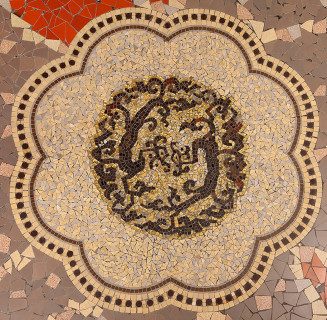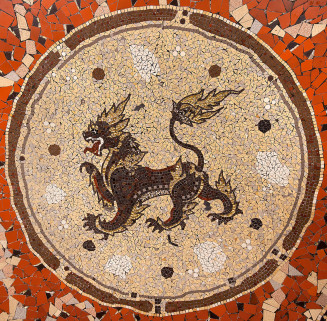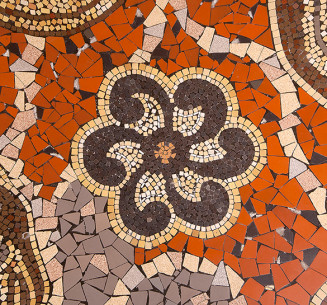Mosaics
The floor of the Hall of Honour, the Forum, the auditorium and the Marie-Curie Hall on the ground floor of the Palais de la Porte Dorée is covered with mosaics stretching over 2,500 m². These were made by the Établissements Gentil & Bourdet, founded in 1901 by the two ceramist-architects Alphonse Gentil (1872-1933) and François Bourdet (1874-1952).

Credit
Photo : Lorenzo © Palais de la Porte Dorée
Legende
Signature of Gentil & Bourdet - Hall of Honour
Credit
© Palais de la Porte Dorée
The Établissements Gentil & Bourdet, located until 1952 in Boulogne-Billancourt, produced most of the porcelain stone and mosaic decors gracing the facades and interiors of many public and private buildings in the first half of the 20th century, adopting the aesthetic codes of each era, notably Art Nouveau (from 1900 to 1920) and Art Deco (from 1920 to 1940).
Their creations can be admired on the facades of many houses in Nancy, the epicentre of Art Nouveau (1901-1905), at the Paris head office of the Société Générale, Boulevard Haussmann (1905-1912), at the Louxor cinema in Paris (1921), in certain Paris metro stations, and notably the waiting room at the Gare Saint-Lazare (1910), and also many swimming pools, especially the one in Roubaix (1931) which became a museum in 2001, etc.

Credit
Photo : Lorenzo © Palais de la Porte Dorée
To create the decorative patterns for the mosaics at the Palais de la Porte Dorée, Gentil & Bourdet used both porcelain stone tiles and tessellas made of stone or glass paste against a gilded background (the small cubes assembled to draw the patterns of the mosaic). The mosaics were delivered stuck onto paper, with the pattern prepared backwards at the factory, facilitating the work of laying them by small surface areas.

Credit
Photo : Lorenzo © Palais de la Porte Dorée
The patterns in red, black, yellow and gold colours were made by Gentil & Bourdet in compliance with the wishes of the architects of the Palais, Albert Laprade and Léon Jaussely, who in the detailed description of the contract signed on August 1930 requested drawings inspired by the “primitive arts of Central Africa” for the Hall of Honour and “Indochinese Art” in the Forum (ex-function room).
While the patterns in the Hall of Honour are geometric amidst flowing, fabric-like bands, the forum features a variety of shapes with a central motif showing figures from Asian mythology: peacock, harnessed elephant, helmeted warrior, Hindu swastika, dragon, palmette…

Credit
Photo : Lorenzo © Palais de la Porte Dorée

Photo : Lorenzo © Palais de la Porte Dorée



